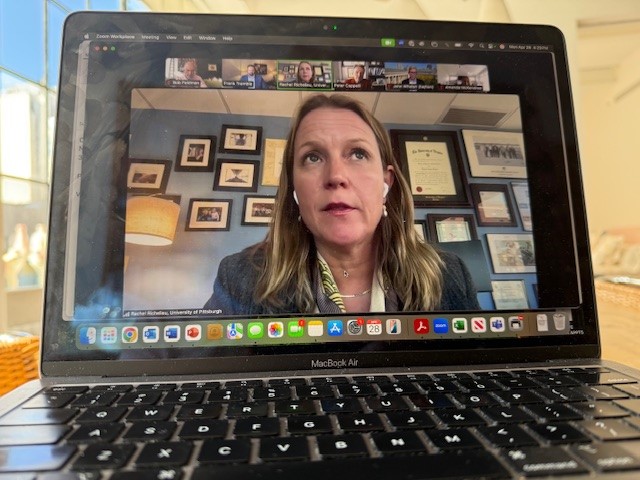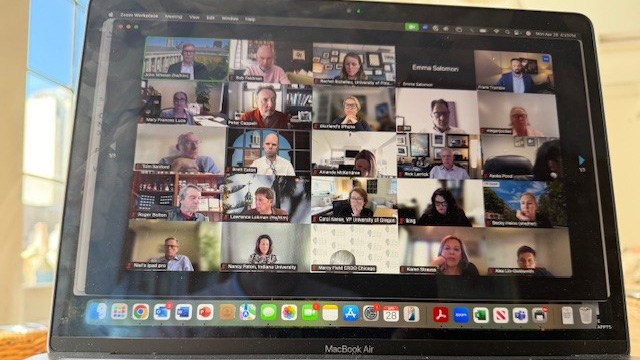The Civility Call
The Civility Call provides a vital forum for senior HR and communications leaders to share best practices on managing workplace tensions during polarized times. Convened in partnership with SHRM and the Page Society, these monthly discussions provide expert insights and best practices from participants’ organizations. Each month, executives engage in candid dialogue after expert-led discussions on pressing topics like navigating political discourse, customer relationships across divides, and supporting employee wellbeing. This open sharing of strategies and experiences is critical, as businesses face escalating civility risks that can disrupt operations and damage reputations.
In an era where institutional trust is declining across sectors, higher education faces particularly steep challenges. University leaders are confronting attacks on academic freedom, evolving admissions landscapes, looming research budget cuts, and managing increasingly diverse stakeholder expectations—all while operating within uniquely complex organizational structures that differ significantly from corporate environments.
These challenges were the focus of the April Civility Call hosted by the Dialogue Project at Duke University in collaboration with SHRM and the Page Society. The virtual discussion featured insights from Peter Capelli, George W. Taylor Professor of Management at the Wharton School; Rachel Richelieu, Vice Chancellor for Communications and Marketing at the University of Pittsburgh; and John Whelan, Vice President of Human Resources at Yale University. Duke University’s Vice President for Marketing, Communications and Public Affairs, Frank Tramble, moderated the conversation.
“A polarized population means a polarized workforce, and virtually every organization has confronted the challenges of dealing with all their stakeholders on a wide range of business and social issues,” said Bob Feldman, founder of the Dialogue Project at Duke, in his opening remarks. The session explored how higher education institutions manage both internal and external pressures while navigating what is often perceived as a politically charged environment.
The Eroding Public Trust in Higher Education

Rachel Richelieu, Vice Chancellor for Communications and Marketing at the University of Pittsburgh, shares sobering statistics on public confidence in higher education.
Universities operate in an environment where public confidence has reached historic lows. Rachel Richelieu shared sobering statistics from recent Gallup polling: “Americans are now nearly divided among those who have a great deal to quite a lot of confidence in higher ed (36%), some confidence (32%), and little to no confidence (32%).” This represents a dramatic shift from 2015, when 57% expressed high confidence and only 10% reported little to none.
Universities are doing a great deal to address this skepticism, including reinforcing their commitment to free speech and civic engagement on campus as well as to access and affordability and equipping students with skills to ensure strong placement rates – either getting jobs or entering graduate school within six months of graduating.
How Universities Differ from Corporations

Peter Capelli, George W. Taylor Professor of Management at The Wharton School, explains the complex relationship between universities and government funding.
The discussion highlighted several fundamental ways in which higher education institutions operate differently from traditional businesses—distinctions that may not be immediately apparent to corporate leaders:
Shared Governance
Unlike the more hierarchical decision-making structures typical in corporations, universities operate through shared governance. “Our faculty, staff, and students come together to really build and co-create and collaborate on policies and governance,” Richelieu explained. This collaborative approach means university presidents lack the unilateral authority often held by corporate CEOs.
Model Based on Government Funding
Universities and the government maintain a symbiotic relationship that dates back generations. Peter Capelli explained this unique financial arrangement: “Half our budget is medical school, and much of the medical school is funded by government grants.” These aren’t donations but rather contractual agreements where the federal government identifies its research priorities and universities compete to address them.
A critical component of this funding model involves “overhead” or indirect costs that support equipment such as MRI machines, and other infrastructure required to support research projects. “The overhead costs are pretty big in most universities. They’re about 60% of the budget,” Capelli noted. These funds compensate for facilities, utilities, support staff, and other operational costs that enable research to happen.
Current policy proposals to cut this overhead rate from 60% to 16% represent an existential threat to research universities. “You can’t support all these capabilities that you’ve built over the last couple of generations,” Capelli warned.
Academic Freedom
Another distinctive feature of higher education is academic freedom—a concept with little parallel in corporate settings. “The general view is that we shouldn’t be constrained in what we want to do by outside pressures,” Capelli explained. This principle ensures that scholars can pursue truth regardless of market pressures or political preferences.
The benefit to society, Capelli argued, is that “virtually every important discovery has been one that challenged the orthodoxy in one way or the other… New ideas, new innovations, new ways of thinking that ultimately have some merit” emerge from this protected intellectual environment.
Reality vs. Media Portrayal
While media coverage often highlights campus protests and conflicts, panelists suggested a more nuanced reality. Capelli observed that “for the most part, the students, most students have no idea about any of these things that you read in the paper. They’ve got their heads down, they’re worrying about their exams, they’re trying to get jobs.”
Perhaps more surprising, faculty report difficulty engaging students in meaningful debate. “We can’t get students to argue,” Capelli noted. “We can’t get them to debate positions. We can’t get them to engage in the kind of dialogue that the pundits outside think should be happening.”
This reluctance stems partly from a campus culture that emphasizes harmony over productive disagreement. As one MBA student told Capelli, students are “inculcated by the culture of the institution… to get along and the idea that disagreements are destructive.”
Financial Challenges on the Horizon

John Whelan, Vice President of Human Resources at Yale University, clarifies common misconceptions about university endowments.
Universities face multiple financial threats beyond the proposed cuts to research funding. International student enrollment—a significant revenue source for many institutions—is declining. Additionally, a potential increase in the excise tax on endowments from 1.4% to as high as 14% or even 30% would severely impact operations.
John Whelan of Yale explained a common misconception about university endowments: “There are rules and there are limitations to how that can be spent, and also it’s really intended to be like a 401k plan to keep the university living for another 300 plus years… If you spend it all now, then it’s like spending your entire retirement savings tomorrow.”
Many institutions are already taking preventive measures. “We’ve already frozen hiring, we are eliminating vacancies, and we are going to have to look at overall what that looks like for employment,” Tramble shared regarding Duke’s approach.
Finding Hope Amid Challenges

Moderator Frank Tramble, Vice President for Marketing, Communications and Public Affairs at Duke University, emphasizes the role of in-person communication in the current context.
Despite these multifaceted challenges, the panelists expressed optimism about the future of higher education.
Richelieu highlighted the impact of proactive communication efforts: “We launched about a month ago our “Research Matters” advocacy campaign. And we’ve gotten very positive feedback and engagement from our faculty and staff who I think needed a bit of opportunity to use their voices.”
Whelan acknowledged the severity of current challenges while maintaining perspective: “Universities have been through a lot in their histories and some have been around for a long time, hundreds of years. And I think they get stronger when they work through times that are challenging… I think we’ll come out of it stronger and better as a result.”
Capelli emphasized practical communication strategies for university leaders: explain the situation clearly, acknowledge what remains uncertain, and express genuine empathy for employees navigating these challenges.
Tramble concluded by stressing the importance of direct human connection: “The power of sitting with people, having difficult conversations with them… in person is always going to still be the best opportunity for you to navigate these [challenges].”
As universities work to rebuild trust and navigate polarization, these insights offer valuable lessons for leaders across all sectors facing similar stakeholder pressures in today’s divisive environment.

